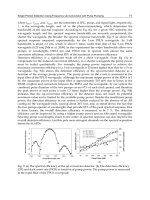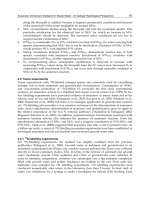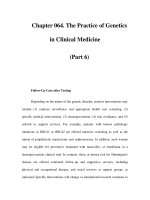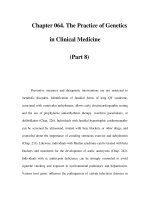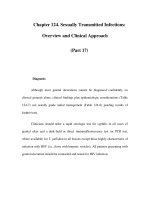Chapter 124. Sexually Transmitted Infections: Overview and Clinical Approach (Part 5) pot
Bạn đang xem bản rút gọn của tài liệu. Xem và tải ngay bản đầy đủ của tài liệu tại đây (15.69 KB, 5 trang )
Chapter 124. Sexually Transmitted Infections:
Overview and Clinical Approach
(Part 5)
1. Treat urethritis promptly, while test results are pending.
Table 124-4 summarizes the steps in management of sexually active men
with urethral discharge and/or dysuria.
Table 124-4 Management of Urethral Discharge in Men
Usual causes
Chlamydia trachomatis
Neisseria gonorrhoeae
Usual initial evaluation
Demonstration of urethral dis
charge or
pyuria
Exclusion of local or systemic
Mycoplasma genitalium
Ureaplasma
urealyticum
Trichomonas vaginalis
Herpes simplex virus
complications
Urethral Gram's stain to confirm urethritis,
detect gram-negative diplococci
Test for N. gonorrhoeae, C. trachomatis
Initial Treatment for Patient and Partners
Treat gonorrhea
(unless excluded):
plus Treat chlamydial infection:
Ceftriaxone, 125 mg
IM; or
Azithromycin, 1 g PO; or
Cefpodoxime, 400 mg
PO; or
Doxycycline, 100 mg bid for
7 days
Cefixime, 400 mg
PO
a
Management of Recurrence
Confirm objective evidence
of urethritis. If patient was reexposed to
untreated or new partner, repeat treatment of patient and partner.
If patient was not reexposed, consider infection with T. vaginalis
b
or
doxycycline-resistant M. genitalium or Ureaplasma, and consider treatment
with
metronidazole, azithromycin, or both.
a
Updates on the availability of cefixime can be obtained from the Centers
for Disease Control and Prevention or state health departments.
b
In men, the diagnosis of T. vaginalis infection requires culture (or
nucleic
acid amplification test, where available) of early-morning first-
voided urine
sediment or of a urethral swab specimen obtained before voiding.
Urethritis in Men: Treatment
In practice, if Gram's stain does not reveal gonococci, urethritis is treated
with a regimen effective for NGU, such as azithromycin (1.0 g PO in a single
dose) or doxycycline (100 mg PO bid for 7 days). Both are effective, although
azithromycin may give better results in M. genitalium infection. If gonococci are
demonstrated by Gram's stain or if no diagnostic tests are performed to exclude
gonorrhea definitively, treatment should include a single-dose regimen for
gonorrhea (Chap. 137) plus azithromycin or doxycycline treatment for C.
trachomatis, which frequently occurs as a urethral co-infection in men with
gonococcal urethritis. Sexual partners should be tested for gonorrhea and
chlamydial infection and should receive the same regimen given to the male index
case. Patients with confirmed persistence or recurrence of urethritis after treatment
should be re-treated with the initial regimen if they did not comply with the
original treatment or were reexposed to an untreated partner. Otherwise, an
intraurethral swab specimen and a first-voided urine sample should be tested for T.
vaginalis (currently best done by culture, although NAATs appear to be more
sensitive and are likely to become commercially available in the future). If
compliance with initial treatment is confirmed and reexposure excluded, the
recommended treatment is with metronidazole or tinidazole (2 g PO in a single
dose) plus azithromycin (1 g PO in a single dose); the azithromycin component is
especially important if this drug has not been given during initial therapy.
